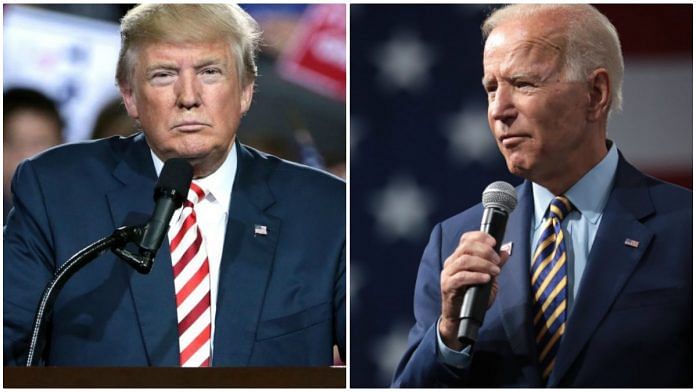New Delhi: Every four years, the two US political parties hold their massive conventions to nominate their respective presidential candidates and agree upon official party platforms for the general election.
This year, even though this once-in-a-century pandemic is ongoing, the two US political parties are going ahead with their conventions but minus the physical crowds. Instead, many will be dialling in virtually.
The Democrats are set to conduct their convention between 17 and 20 August at Milwaukee, Wisconsin — where former vice-president Joe Biden will be nominated as the official Democratic presidential candidate. Meanwhile, the Republicans will hold their convention between 24 and 27 August at Charlotte, North Carolina, to nominate President Donald Trump.
These conventions are going to look less a gathering of the faithful pledging their support and more of a virtual formality.
ThePrint looks at what the US political conventions are all about and how are they different this year.
Also read: With less than 100 days to the US election, Donald Trump is panicking & its showing
The origin of conventions
US Democratic and Republican conventions are symbolic meetings for electing the presidential candidates, featuring speeches by important leaders, and officially kickstarting the presidential campaign for both the incumbent and the challenger. But this was not always the case, and back in the day, these political conventions used to serve a purpose.
It was at these conventions that party bosses used to select the presidential candidates. The Federalist Party invented the presidential nomination convention, involving secret national meetings to pick candidates, in 1808, though the first significant meeting took place was in 1812.
The value of these conventions became prominent in 1824, when several factions of the Democratic-Republican Party rejected the caucus presidential nominee, William Crawford, and instead nominated John Quincy Adams, Andrew Jackson, and Henry Clay. Adams was eventually the final nominee, and went on to serve as the sixth president of the US.
After that, for over a century, the presidential nomination conventions developed the image of smoke-filled rooms, where the party bosses chose the candidate.
But, from the early 1970s, conventions transformed from these meetings of the high-party bosses to more public events.
“Smoke-filled rooms evolved from conventions without predetermined nominees that went on for multiple ballots. That hasn’t happened in more than 50 years because voters didn’t want party bosses deciding the presidential nominees,” said Adam Levy of the CNN.
“Both parties have made changes to the system that began in earnest after 1968. Adding primaries instead of caucuses, creating more pledged delegates that reflect the people’s votes, and public transparency all played a role in the system we have today.”
Also read: India ‘overwhelmingly’ reaches out to Democrats as Biden and Harris woo Indian Americans
How conventions look now
Today’s conventions are mega events that officially see the nomination of each party’ presidential candidate. “Usually, thousands of delegates would gather in an arena. The delegation from each state is called upon, someone from the state extols its greatness and then announces how many of its delegates it’s pledging for each candidate,” noted a report in the Washington Post.
But these conventions also serve a whole range of other purposes.
First, several party leaders, through their speeches, endorse the presidential candidate of their respective parties. For instance, Democratic party’s Bernie Sanders or Elizabeth Warren stood against Joe Biden during the primaries, but their endorsement of Biden now at the Democratic National Convention (DNC) would be seen as them encouraging their supporters to vote for Biden.
Second, almost all the important party leaders give a speech during these presidential conventions — and thus, set up the party platform for the upcoming general elections.
This year’s speciality for the conventions
Given the Covid-19 pandemic, the very nature of these conventions is set to change. For instance, the process of each state’s delegation being called on the stage to pledge their number of delegates and announce their official presidential nomination will now be done virtually in less than 30 minutes. But there are several other changes.
This years conventions are not going to feature any crowds. If the key purpose of these conventions is to officially launch the election campaign of the candidate, it is hard to do it without crowds.
According to DNC’s chief operation officer Andrew Binns, “At a regular convention, audience reaction is a huge part of the speeches. We needed a way to do that technologically and virtually.”
To get around this problem, the Democratic party has replaced crowds with hundreds of live-feeds, to be able to create the impression of party celebrations.
“Over four nights starting Monday, a behind-the-scenes crew of about 400 with operation centers in New York, Milwaukee, Los Angeles and Wilmington, Del., plans to broadcast to the nation hundreds of live video feeds from living rooms, national monuments and stages around the country, according to interviews with three people involved in planning the event,” noted the Washington Post report.
The DNC will see virtual speeches by Bernie Sanders, Michelle Obama, Amy Kloubuchar Monday. Alexandria Ocasio-Cortez, Bill Clinton and John Kerry will speak Tuesday. Meanwhile, Kamala Harris, Barack Obama, Hilary Clinton, Elizabeth Warren and Nancy Pelosi will speak Wednesday. And finally, presidential candidate Joe Biden will speak Thursday.
Also read: Hinduphobia makes Kamala Harris’ identity a liability. So she is ‘Black’ in US media
At the Republican convention
The Republican convention, which begins 20 August, is expected to see Trump accept the Republican presidential nomination virtually from the White House.
According to Florida Republican Ford O’Connell, the final speech by Trump could be a chance for him to move away from the debate regarding his handling of the coronavirus pandemic, and focus on other things.
Also read: Why US-China tensions will continue to mount during Trump’s re-election bid



